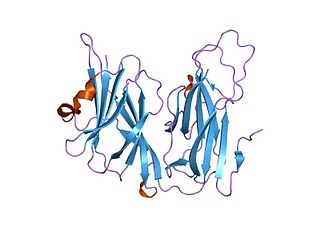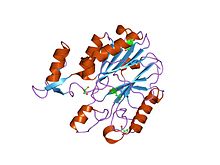In biology and biochemistry, protease inhibitors, or antiproteases, are molecules that inhibit the function of proteases. Many naturally occurring protease inhibitors are proteins.

Ceruloplasmin is a ferroxidase enzyme that in humans is encoded by the CP gene.
Copper proteins are proteins that contain one or more copper ions as prosthetic groups. Copper proteins are found in all forms of air-breathing life. These proteins are usually associated with electron-transfer with or without the involvement of oxygen (O2). Some organisms even use copper proteins to carry oxygen instead of iron proteins. A prominent copper proteins in humans is in cytochrome c oxidase (cco). The enzyme cco mediates the controlled combustion that produces ATP.
Catechol oxidase is a copper oxidase that contains a type 3 di-copper cofactor and catalyzes the oxidation of ortho-diphenols into ortho-quinones coupled with the reduction of molecular oxygen to water. It is present in a variety of species of plants and fungi including Ipomoea batatas and Camellia sinensis. Metalloenzymes with type 3 copper centers are characterized by their ability to reversibly bind dioxygen at ambient conditions. In plants, catechol oxidase plays a key role in enzymatic browning by catalyzing the oxidation of catechol to o-quinone in the presence of oxygen, which can rapidly polymerize to form the melanin that grants damaged fruits their dark brown coloration.
Nitrite reductase refers to any of several classes of enzymes that catalyze the reduction of nitrite. There are two classes of NIR's. A multi haem enzyme reduces NO2− to a variety of products. Copper containing enzymes carry out a single electron transfer to produce nitric oxide.

Vitamin K epoxide reductase (VKOR) is an enzyme that reduces vitamin K after it has been oxidised in the carboxylation of glutamic acid residues in blood coagulation enzymes. VKOR is a member of a large family of predicted enzymes that are present in vertebrates, Drosophila, plants, bacteria and archaea. In some plant and bacterial homologues, the VKOR domain is fused with domains of the thioredoxin family of oxidoreductases.

Hephaestin, also known as HEPH, is a protein which in humans is encoded by the HEPH gene.
Laccases are multicopper oxidases found in plants, fungi, and bacteria. Laccases oxidize a variety of phenolic substrates, performing one-electron oxidations, leading to crosslinking. For example, laccases play a role in the formation of lignin by promoting the oxidative coupling of monolignols, a family of naturally occurring phenols. Other laccases, such as those produced by the fungus Pleurotus ostreatus, play a role in the degradation of lignin, and can therefore be classed as lignin-modifying enzymes. Other laccases produced by fungi can facilitate the biosynthesis of melanin pigments. Laccases catalyze ring cleavage of aromatic compounds.

Amine oxidase (copper-containing) (AOC) (EC 1.4.3.21 and EC 1.4.3.22; formerly EC 1.4.3.6) is a family of amine oxidase enzymes which includes both primary-amine oxidase and diamine oxidase; these enzymes catalyze the oxidation of a wide range of biogenic amines including many neurotransmitters, histamine and xenobiotic amines. They act as a disulphide-linked homodimer. They catalyse the oxidation of primary amines to aldehydes, with the subsequent release of ammonia and hydrogen peroxide, which requires one copper ion per subunit and topaquinone as cofactor:
The aldehyde oxidase and xanthine dehydrogenase, a/b hammerhead domain is an evolutionary conserved protein domain.
Isocitrate lyase family is a family of evolutionarily related proteins.
Haem peroxidases (or heme peroxidases) are haem-containing enzymes that use hydrogen peroxide as the electron acceptor to catalyse a number of oxidative reactions. Most haem peroxidases follow the reaction scheme:
Fet3p is a multicopper oxidase (MCO)2 found in Saccharomyces cerevisiae with a structure consisting of three cupredoxin-like β-barrel domains and four copper ions located in three distinct metal sites (T1 in domain 3, T2, and the binuclear T3 at the interface between domains 1 and 3). Fet3p is a type I membrane protein with an orientation that places the amino-terminal oxidase domain in the exocellular space (Nexo) and the carboxyl terminus in the cytoplasm (Ccyt).

In molecular biology, the copper type II ascorbate-dependent monooxygenases are a class of enzymes that require copper as a cofactor and which use ascorbate as an electron donor. This family contains two related enzymes, dopamine beta-monooxygenase EC 1.14.17.1 and peptidylglycine alpha-amidating monooxygenase EC 1.14.17.3. There are a few regions of sequence similarities between these two enzymes, two of these regions contain clusters of conserved histidine residues which are most probably involved in binding copper.

The cupin superfamily is a diverse superfamily of proteins named after its conserved barrel domain. The superfamily includes a wide variety of enzymes as well as non-enzymatic seed storage proteins.

In molecular biology the FGGY carbohydrate kinase family is a family of evolutionarily related carbohydrate kinase enzymes. These enzymes include L-fuculokinase EC 2.7.1.51 ; gluconokinase EC 2.7.1.12 ; glycerol kinase EC 2.7.1.30 ; xylulokinase EC 2.7.1.17 ; D-ribulose kinase EC 2.7.1.47 ; and L-xylulose kinase EC 2.7.1.53. These enzymes are proteins of from 480 to 520 amino acid residues.

In molecular biology, the glucose-methanol-choline oxidoreductase family is a family of enzymes with oxidoreductase activity.

Cytochrome d, previously known as cytochrome a2, is a name for all cytochromes that contain heme D as a cofactor. Two unrelated classes of cytochrome d are known: Cytochrome bd, an enzyme that generates a charge across the membrane so that protons will move, and cytochrome cd1, a nitrite reductase.

Galactose oxidase is an enzyme that catalyzes the oxidation of D-galactose in some species of fungi.
The iron/lead transporter (ILT) family is a family of transmembrane proteins within the lysine exporter (LysE) superfamily. The ILT family includes two subfamilies, the iron-transporting (OFeT) family and the lead-transporting (PbrT) family. A representative list of the proteins belonging to these subfamilies of the ILT family can be found in the Transporter Classification Database.













